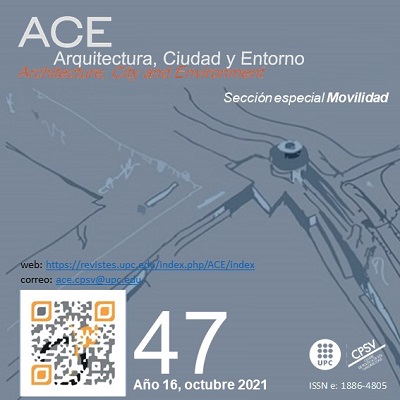Approach to urban habitability from everyday mobility and urban proximity. Case of the urban coastal region of Puerto Vallarta-Bahía de Banderas, Mexico
DOI:
https://doi.org/10.5821/ace.16.47.10686Keywords:
Everiday mobility, proximity, habitability, coastal urban regionAbstract
The aim of this research was to identify the structure and habitability of the Touristic Urban Region Puerto Vallarta-Bahía de Banderas through everyday mobility and dynamics of proximity, the latter considered as an indicator of habitability. The data on everyday mobility come from the survey carried out in 2011 for the research “Urban Tourist Regions” (CONACYT CB-103363) and from the Intercensal Survey 2015, while the demographic and territorial data come from the 2005 Population and Housing Count of the General Population and Housing Census 2010 and of the vector information of the Geostatistical Framework version 5.0 of the INEGI. The results showed a polycentric urban structure whose everyday mobility is based on two-time scales: the first at neighborhood scale, with daily travels of up to 15 minutes; the second at interurban scale, with daily travels between 16 and 60 minutes using motorized transport. The modal distribution showed a predominance of journeys using motorized transport in the Main Node (Puerto Vallarta), the Integrated Urban Settlements, the Touristic Urban Settlements with further consolidation, and the Immigrant Receiving Urban Settlements with formal growth. Pedestrian travels have greater representation in Immigrant Receiving Urban Settlements (with mostly informal growth), Settlements with Tourist Vocation (with less consolidation) and more remote Rural-Urban Transition Settlements (with less access to motorized transport), either because the socioeconomic status of its residents or because the lesser service coverage of public transport. So, dynamics of proximity are presented as a resilient capability of communities with lower socioeconomic and physical access to motorized transportation; they also provide some components of habitability.
Downloads
Published
Issue
Section
License
| INTELECTUAL PROTECTION CRITERIA |
At this moment, it is count with the "Oficina Española de Patentes y Marcas", while global protection it is being processed by the World Intelectual Property Organization (OMPI/WIPO). Nevertheless the International Standard Serial Number Office (ISSN) has given the following numbers ISSN: 1886-4805 (electronic version) and 1887-7052 (paper version). All articles will be peer reviewed, using double blind reviewing. |
| COPYRIGHT |
The article contents and their comments are authors exclusive liability, and do not reflect necessarily the journal editor commitee's opinion. All ACE published works are subject to the following licence CC BY-NC-ND 3.0 ES http://creativecommons.org/licenses/by-nc-nd/3.0/es/ It implies that authors do not hold nor retain the copyright without restrictions but only those included in the licence. |





































